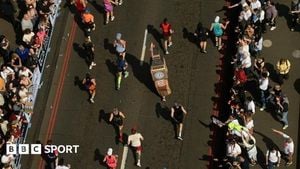On March 21, 2025, Sky Atlantic premiered the highly-anticipated series "Gangs of Milano – Le nuove storie del Blocco" at 21:15, available for streaming on NOW. This sequel to "Blocco 181," which captivated audiences back in 2022, dives deeper into the multi-ethnic outskirts of Milan, exploring themes of power, identity, and belonging.
Directed and co-written by Ciro Visco, known for his work on "Gomorra – La serie," this original Sky production comprises eight episodes. Two episodes will air every Friday evening over the course of four weeks, while reruns will be featured on Saturday and Sunday nights. The season finale is slated for April 11, 2025.
The narrative centers on three protagonists ensnared in a world rife with violence and gang warfare: Bea, played by Laura Osma; Ludo, portrayed by Alessandro Piavani; and Mahdi, played by Andrea Dodero. Bea leads a female gang, the Misa, operating in the affluent clubs of Milan, while Mahdi has taken over the Blocco, managing his family's criminal legacy. Ludo, returning from a prolonged absence, brings his own set of secrets and desires for vengeance.
Salmo, the Italian rapper, returns as Snake, whose character is embroiled in complex schemes and connections. He plays a pivotal role in the sixth episode, titled "BÈN DÀN," which also features Elisa Wong and Alessandro Borghi.
Despite its Milanese setting, much of "Gangs of Milano" was filmed in Turin due to economic constraints associated with production costs in Milan. Key filming locations include the Barriera di Milano and Falchera neighborhoods, where the gritty dynamics of gang conflicts were recreated convincingly. These areas provided an authentic backdrop, essential for the series' portrayal of the harsh realities in the city’s outskirts.
In addition to the urban settings, Cultural Heritage is woven into the storyline, reflecting the divergence of wealth between the suburbs and the city center. Locations like the stylish Via Roma and the historic Piazza San Carlo illustrate the luxurious side of Milan, starkly juxtaposed with the pressures experienced by characters like Bea and Mahdi in their daily struggles.
The series tackles urgent social issues relevant to contemporary Italy, including evictions, social inequalities, and gang violence. “We have captured the last social upheavals, opening a parallel dimension compared to that of Blocco 181,” producer Nils Hartmann stated during a press event, emphasizing the show's thematic relevance in light of recent urban tensions.
Paolo Vari, another screenwriter, further articulated, “We have hardened with the reality,” confirming that the script reflects the gritty hardships of life in the city's shadows. The emotional depth of the characters and their environments enhances the narrative, creating a compelling drama that is more than just a crime story.
As the plot thickens, the Kasba emerges— a group led by young, multicultural figures like Zak (played by debutant Fahd Triki) and Nael (Noè Nouh Batita). Together, they represent an audacious challenge to the established order, using their music as both a form of expression and a means of survival.
Music also plays a vital role, with Salmo curating a culturally rich soundtrack that intertwines various genres, including trap, drill, and techno. This musical landscape serves to heighten the emotional resonance of the series, showcasing the passion and rage of youth navigating precarious lives framed by systemic inequality.
With a gripping storyline that resonates with both young audiences and seasoned viewers, "Gangs of Milano – Le nuove storie del Blocco" is set to challenge perceptions of urban life in Milan. The mix of drama, action, and social commentary ensures a multifaceted viewing experience.
In a city often defined by glitz and glamour, this series peels back layers to reveal the stark truth and struggles faced by its youth. Through the lenses of its diverse characters, it promises a narrative that is both timely and deeply affecting—offering insights into the contemporary Italian landscape while thrilling audiences week after week.
This unique approach creates not only a thrilling watch but also a profound opportunity for reflection on the state of urban communities. The intersection of art and life in Milan, as captured by the series, invites viewers to rethink their understanding of identity, belonging, and the harsh realities that shape the lives of its inhabitants.



